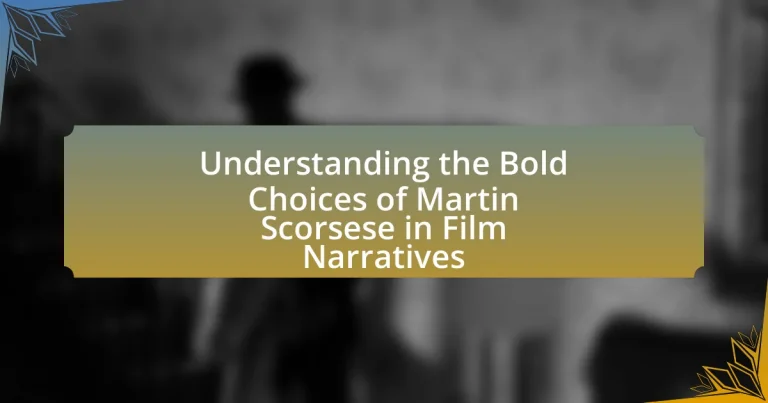The article examines the bold narrative choices of Martin Scorsese, a pivotal figure in contemporary cinema. It highlights his use of non-linear storytelling, complex character development, and exploration of moral ambiguity, as seen in films like “Goodfellas,” “Taxi Driver,” and “The Wolf of Wall Street.” The discussion includes how these techniques shape storytelling, influence audience perception, and reflect Scorsese’s personal experiences and cultural contexts. Additionally, it addresses the legacy of Scorsese’s innovative approaches on modern filmmakers and the best practices that can be derived from his work.

What are the Bold Choices of Martin Scorsese in Film Narratives?
Martin Scorsese’s bold choices in film narratives include the use of non-linear storytelling, complex character development, and the exploration of moral ambiguity. Non-linear storytelling is exemplified in “Goodfellas,” where the narrative jumps through time, enhancing the viewer’s engagement and understanding of the characters’ motivations. Scorsese’s characters often exhibit deep psychological complexity, as seen in “Taxi Driver,” where the protagonist’s descent into madness reflects broader societal issues. Additionally, his exploration of moral ambiguity challenges traditional notions of good and evil, particularly in “The Wolf of Wall Street,” where the anti-hero’s unethical behavior is presented in a captivating manner, prompting audiences to question their own values. These choices have significantly influenced contemporary cinema, showcasing Scorsese’s innovative approach to storytelling.
How do Scorsese’s choices shape the storytelling in his films?
Scorsese’s choices significantly shape the storytelling in his films through his distinctive use of narrative structure, character development, and visual style. His preference for non-linear storytelling, as seen in “Goodfellas,” allows for a more immersive experience, engaging viewers by revealing character motivations and consequences in a dynamic manner. Additionally, Scorsese’s focus on flawed, complex characters, often portrayed by actors like Robert De Niro, deepens emotional resonance and invites audiences to explore moral ambiguities. His meticulous attention to detail in cinematography, including the use of tracking shots and vibrant soundtracks, enhances the narrative’s emotional impact, exemplified in “Taxi Driver” and “The Irishman.” These choices collectively create a rich tapestry of storytelling that challenges viewers and reflects the complexities of human nature.
What narrative techniques does Scorsese frequently employ?
Martin Scorsese frequently employs narrative techniques such as voice-over narration, nonlinear storytelling, and the use of music to enhance emotional impact. Voice-over narration allows characters to provide personal insights, as seen in “Goodfellas,” where Henry Hill’s perspective shapes the audience’s understanding of the story. Nonlinear storytelling is evident in films like “The Irishman,” where the timeline shifts to create suspense and depth in character development. Additionally, Scorsese’s strategic use of music, often integrating popular songs to evoke specific moods or themes, is a hallmark of his style, exemplified in “Casino” and “Mean Streets.” These techniques collectively contribute to the immersive and dynamic nature of his films.
How do these techniques influence audience perception?
Martin Scorsese’s techniques, such as non-linear storytelling, dynamic editing, and character-driven narratives, significantly influence audience perception by creating a more immersive and emotionally engaging experience. These methods challenge traditional narrative structures, prompting viewers to actively piece together the story, which enhances their investment in the characters and themes. For instance, Scorsese’s use of voice-over narration in films like “Goodfellas” provides insight into characters’ thoughts, shaping how audiences perceive their motivations and moral complexities. This approach not only deepens emotional resonance but also encourages critical reflection on the narrative, as evidenced by the film’s reception and analysis in academic discussions, such as those found in “The Cinema of Martin Scorsese” by David A. Cook.
Why are Scorsese’s films considered groundbreaking?
Scorsese’s films are considered groundbreaking due to their innovative storytelling techniques and exploration of complex themes. His use of non-linear narratives, as seen in “Goodfellas,” challenges traditional cinematic structures, allowing for a more immersive experience. Additionally, Scorsese’s focus on moral ambiguity and the psychological depth of characters, particularly in films like “Taxi Driver,” pushes the boundaries of character development in cinema. His collaboration with notable cinematographers and editors has also resulted in visually striking compositions that enhance narrative impact, exemplified by the dynamic camera work in “The Wolf of Wall Street.” These elements collectively establish Scorsese as a pivotal figure in redefining modern filmmaking.
What themes are prevalent in Scorsese’s filmography?
Prevalent themes in Martin Scorsese’s filmography include violence, morality, and the American Dream. Scorsese often explores the complexities of human nature, particularly through characters who grapple with their moral choices in violent environments, as seen in films like “Taxi Driver” and “Goodfellas.” Additionally, he examines the disillusionment of the American Dream, portraying characters who pursue success but ultimately face moral and existential crises, evident in “The Wolf of Wall Street.” These themes are reinforced by Scorsese’s distinctive storytelling style and his focus on character-driven narratives, making them central to his cinematic identity.
How does Scorsese challenge traditional narrative structures?
Martin Scorsese challenges traditional narrative structures by employing non-linear storytelling, unreliable narrators, and fragmented timelines. For instance, in “Goodfellas,” Scorsese uses a chronological disarray that mirrors the chaotic lives of the characters, allowing viewers to experience the disorientation of the criminal world. Additionally, his use of voice-over narration often presents subjective perspectives, as seen in “Casino,” where the narrators’ biases shape the audience’s understanding of events. This approach not only subverts conventional plot progression but also invites deeper engagement with character psychology and moral ambiguity, reinforcing the complexity of human experience in his films.
What Influences Shape Scorsese’s Narrative Choices?
Martin Scorsese’s narrative choices are shaped by a combination of personal experiences, cultural influences, and cinematic traditions. His upbringing in New York City, particularly in Italian-American neighborhoods, informs the themes of identity, morality, and violence prevalent in his films. Scorsese’s deep appreciation for classic cinema, especially the works of directors like Alfred Hitchcock and Federico Fellini, also influences his storytelling techniques and visual style. Additionally, his exploration of themes such as guilt and redemption reflects his own Catholic upbringing, which adds a layer of complexity to his characters and narratives. These influences collectively contribute to the distinctive and bold narrative choices that define Scorsese’s filmography.
How do personal experiences inform Scorsese’s storytelling?
Personal experiences significantly inform Martin Scorsese’s storytelling by providing authentic emotional depth and cultural context. Scorsese’s upbringing in New York City’s Little Italy, characterized by a strong Italian-American identity and exposure to organized crime, shapes the themes and characters in his films, such as “Goodfellas” and “Casino.” His personal struggles with faith and identity are reflected in works like “Taxi Driver” and “The Last Temptation of Christ,” where he explores complex moral dilemmas. These autobiographical elements enhance the relatability and realism of his narratives, allowing audiences to connect with the characters on a deeper level.
What role does Scorsese’s upbringing play in his films?
Scorsese’s upbringing significantly influences his films, particularly through themes of identity, morality, and the Italian-American experience. Growing up in New York City’s Little Italy, Scorsese was immersed in a culturally rich environment that shaped his storytelling. His experiences with family dynamics, Catholicism, and the struggles of immigrant life are reflected in films like “Mean Streets” and “Goodfellas,” where characters grapple with loyalty, guilt, and the quest for belonging. These elements provide a nuanced perspective on the complexities of human behavior, making his narratives deeply personal and relatable.
How do historical and cultural contexts influence his narratives?
Historical and cultural contexts significantly influence Martin Scorsese’s narratives by shaping the themes, character development, and moral complexities within his films. Scorsese often draws from his Italian-American heritage and the socio-political landscape of the 20th century, which informs the portrayal of identity, crime, and redemption in works like “Goodfellas” and “The Irishman.” For instance, the depiction of organized crime in “Goodfellas” reflects the real-life experiences of Italian-American communities during the post-World War II era, highlighting issues of loyalty and betrayal. Additionally, Scorsese’s engagement with historical events, such as the Vietnam War in “Taxi Driver,” illustrates how cultural trauma and societal disillusionment shape individual psyches and narratives. These elements demonstrate that Scorsese’s films are not only artistic expressions but also reflections of the historical and cultural realities that inform his storytelling.
What filmmakers or movements have inspired Scorsese?
Martin Scorsese has been inspired by various filmmakers and movements, notably the French New Wave, Italian Neorealism, and directors such as John Ford and Alfred Hitchcock. The French New Wave influenced Scorsese’s narrative style and editing techniques, while Italian Neorealism shaped his focus on realism and character-driven stories. Scorsese has cited John Ford’s mastery of visual storytelling and Alfred Hitchcock’s psychological depth as significant influences on his filmmaking approach. These inspirations are evident in Scorsese’s works, which often blend innovative techniques with rich character exploration.
How does Scorsese’s work reflect the influence of Italian Neorealism?
Scorsese’s work reflects the influence of Italian Neorealism through its focus on authentic storytelling, complex characters, and the depiction of urban life. His films often portray the struggles of marginalized individuals, similar to the Neorealist emphasis on the everyday experiences of the working class. For instance, in “Mean Streets,” Scorsese captures the gritty reality of life in New York’s Little Italy, showcasing the moral dilemmas faced by his characters, which aligns with the Neorealist tradition of exploring human resilience in challenging circumstances. Additionally, Scorsese employs naturalistic dialogue and location shooting, techniques that are hallmarks of Italian Neorealism, further grounding his narratives in a sense of realism.
In what ways does Scorsese pay homage to classic cinema?
Martin Scorsese pays homage to classic cinema through his use of stylistic elements, narrative techniques, and thematic references. He often incorporates techniques such as long tracking shots and dynamic editing, reminiscent of filmmakers like Alfred Hitchcock and Orson Welles. Scorsese’s films frequently feature classic film references, such as the use of iconic music scores and visual motifs that echo the works of directors like Federico Fellini and Jean-Luc Godard. Additionally, he explores themes of morality and identity, which are prevalent in classic films, thereby connecting contemporary audiences with the cinematic traditions of the past.
How Do Scorsese’s Choices Impact Film Narratives Today?
Scorsese’s choices significantly impact film narratives today by emphasizing character complexity and moral ambiguity. His films often feature antiheroes, such as in “Taxi Driver” and “Goodfellas,” which challenge traditional narrative structures and invite audiences to explore the darker aspects of human nature. This approach has influenced contemporary filmmakers, leading to a rise in narratives that prioritize flawed characters and intricate storytelling. For instance, the success of series like “Breaking Bad” and films like “The Wolf of Wall Street” reflects Scorsese’s legacy, as they similarly delve into the psychological depth of their protagonists, showcasing the lasting effect of his narrative style on modern cinema.
What legacy has Scorsese left on contemporary filmmakers?
Martin Scorsese has left a profound legacy on contemporary filmmakers by pioneering innovative storytelling techniques and character development. His emphasis on complex narratives, moral ambiguity, and the exploration of violence has influenced a generation of directors, encouraging them to delve deeper into the psychological aspects of their characters. Scorsese’s films, such as “Taxi Driver” and “Goodfellas,” showcase his unique ability to blend realism with stylistic flair, setting a benchmark for cinematic expression. This approach has inspired filmmakers like Quentin Tarantino and David Fincher, who adopt similar narrative structures and thematic explorations in their works. Scorsese’s commitment to authenticity and his use of music as a narrative device further solidify his impact, as seen in films like “Casino” and “The Wolf of Wall Street,” where soundtracks enhance emotional resonance and storytelling.
How do modern directors incorporate Scorsese’s techniques?
Modern directors incorporate Scorsese’s techniques by utilizing his signature narrative styles, such as non-linear storytelling and character-driven plots. For instance, filmmakers like Quentin Tarantino and David O. Russell have adopted Scorsese’s approach to complex character arcs and moral ambiguity, often showcasing flawed protagonists in morally challenging situations. Additionally, the use of dynamic camera movements and a strong emphasis on music to enhance emotional impact, as seen in Scorsese’s films like “Goodfellas,” is mirrored in works by directors such as Edgar Wright and Damien Chazelle. These directors often employ similar editing techniques and soundtracks to create a visceral viewing experience, reflecting Scorsese’s influence on contemporary cinema.
What are some examples of films influenced by Scorsese’s style?
Films influenced by Martin Scorsese’s style include “Goodfellas,” “The Departed,” and “Casino.” These films exhibit Scorsese’s signature techniques such as dynamic editing, voice-over narration, and complex character development. For instance, “Goodfellas” employs a fast-paced narrative and a distinctive use of music that mirrors Scorsese’s earlier works, establishing a template for crime dramas. “The Departed” showcases his ability to create tension and moral ambiguity, reflecting the intricate storytelling found in “Mean Streets.” “Casino” further illustrates Scorsese’s exploration of themes like power and betrayal, solidifying his impact on the genre.
What can aspiring filmmakers learn from Scorsese’s approach?
Aspiring filmmakers can learn the importance of character-driven storytelling from Martin Scorsese’s approach. Scorsese emphasizes deep character development, often exploring complex moral dilemmas and psychological motivations, as seen in films like “Taxi Driver” and “Goodfellas.” His use of narrative techniques, such as voice-over narration and non-linear storytelling, enhances the emotional depth and engagement of the audience. Furthermore, Scorsese’s collaboration with talented cinematographers and editors showcases the significance of visual style and pacing in conveying a film’s themes effectively. This focus on character and craftsmanship illustrates how aspiring filmmakers can create compelling narratives that resonate with viewers.
What best practices can be derived from Scorsese’s narrative strategies?
Best practices derived from Scorsese’s narrative strategies include the use of non-linear storytelling, strong character development, and the integration of music to enhance emotional impact. Non-linear storytelling, as seen in films like “Goodfellas,” allows for a dynamic exploration of time and perspective, engaging the audience more deeply. Strong character development is evident in “Taxi Driver,” where the protagonist’s psychological complexity drives the narrative, making the audience invest in his journey. Additionally, Scorsese’s strategic use of music, such as in “Casino,” underscores key moments and evokes specific emotions, reinforcing the narrative’s themes. These practices demonstrate effective techniques for creating compelling and memorable cinematic experiences.
How can filmmakers effectively balance bold choices with audience engagement?
Filmmakers can effectively balance bold choices with audience engagement by integrating innovative storytelling techniques while maintaining relatable themes. For instance, Martin Scorsese often employs unconventional narrative structures and complex characters, yet he grounds these elements in universal human experiences, making them accessible to a broad audience. Research indicates that films that blend originality with familiar emotional arcs tend to resonate more with viewers, as evidenced by Scorsese’s works like “Goodfellas” and “The Wolf of Wall Street,” which showcase unique stylistic choices while exploring themes of ambition and morality that audiences can connect with.


